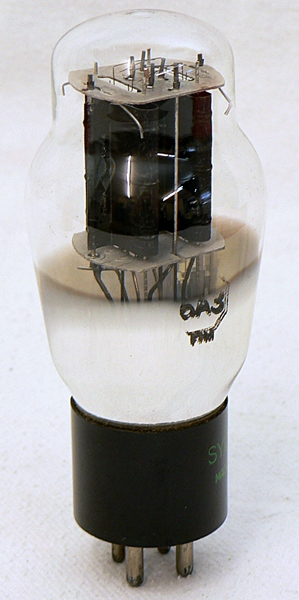|
6A3Sensibly equivalent¶ to:CV730
|
|
|

|
Type 6A3 was the American answer to the British type PX4 and has very similar characteristics and performance, although differing in filament voltage. The principal difference is that whereas the PX4 is based on a two-sided planar construction the 6A3 is based on two conventional electrode assemblies wired directly in parallel in order to obtain a very low Ra value (800 Ohms). Both types deliver around 3.5 Watts when used at 250 V HT.There was also a type 2A3 which was similar except for filament rating (2.5V, 2.5A). Both versions thus consume 6.3 W which is rather more than the 4 W (4 V, 1 A) consumed by most PX4s.The practice of wiring two valve assemblies directly in parallel, without 'stopper' resistances, risks the possibility of low-level parasitic oscillation in push-pull mode at very high frequency (as many experimenters have discovered!). We are not aware that the 6A3 contained integral anti-parasitic 'stoppers'. Perhaps the gain (μ = 5) was too low to support oscillation.Although at one time quite widely used (often in pairs) in the US, the 6A3 was never the equal of the PX4 and never achieved cult status.This audio output triode is directly heated, and is unusual in that the envelope contains two separate electrode systems that are internally connected in parallel. The output of 3.2 Watts is not large for such a compound valve.The classic envelope is 48 mm in diameter and, excluding the UX4 base pins, is 115 mm tall.References: Private communication, data-sheet & 4040. Type 6A3 was first introduced in 1940. See also 1940 adverts. |
Pin Connections
| 1 | 2 | 3 | 4 |  f+ | a | g1 | f- |
|
|
Absolute Maximum Operating Conditions¶
| Vh | Ah | Va | Vg | mAa | ra | gm | Pout | 
| 6.3 | 1.0 | 250 | -45 | 60 | 800 | 5.25 | 3.2W |
|
Updated December19, 2012.
|
|